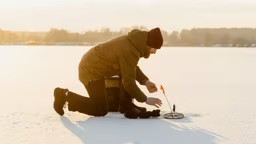
A curious and somewhat disturbing tradition occurs every New Year’s Day at high noon on a secluded lake in the heart of northern Wisconsin’s lake country: Brave, albeit foolhardy, members of my family – the Schimmels – and the Neimon family don swim trunks and jump feet first into a carefully constructed hole in the ice to take the “polar plunge.”
Frigid Tradition
Our traditional leap into the cool January waters got its start on the southwestern shore of Lake Michigan 25-plus years ago. That’s when Dr. Robert Neimon (Dr. Bob) and his brother, Michael, joined the hometown Milwaukee Polar Bear Plungers. I joined the brothers some years into the competition.
Since their first plunge, the brothers have vowed not to miss a year. So when our families each built a cabin on the same lake in northern Wisconsin, the annual tradition migrated from Lake Michigan to the north. The brothers still jump every year, each hoping to outdo the other to take the family “without a miss” honors.
Our families were regular visitors to northern Wisconsin in the warmer months, but having vacation homes in the area afforded us the opportunity to visit year-round.
We soon discovered the beauty and fun activities of a northern Wisconsin winter. The annual New Year’s Day polar plunge is at the top of our list, and now my sons, Lang and Luke, and my brother George occasionally join in.
How Deep To Dive
The northern Wisconsin jump requires a different strategy than the Lake Michigan plunge, in which participants run into the lake and jump into its rolling waves. For the north-country event, we have to cut a 4- to 5-foot hole through the ice with a chain saw. Determining the perfect depth of the water below is key to a successful, safe jump.
Perfect water depth allows the jumper to stand on the bottom of the lake easily with head and chest exposed. Jumping into water that’s too deep is strictly avoided for safety reasons. And landing in water that’s too shallow means the jumper has to double dip: The first landing leaves too much of the body exposed, requiring the jumper to duck into the water. It’s a fate that’s best avoided. Once you hit the water, you quickly realize that once is more than enough.
Each year, our families try to determine the correct area in which to saw the hole in the ice by estimating where the pier ended the prior summer. Fluctuating water levels can make this process a bit more art than science. One year’s miscalculations led to chest-deep water; a ladder was installed to assist with exiting. Another year, the water was thigh high.
Rules & Technique
The only rule is that the jumper needs to go completely underwater. No points for style. Once in the water, frolicking is optional but encouraged. After coming out of the water, a support staff is quick to furnish towels and dry clothes. Drying off quickly is very important; a blazing bonfire on the beach comes in handy. My wife, Maureen, along with Dr. Bob’s wife, Jill, and visiting guests and neighbors watch the event, offer encouragement, staff the “towel crew” and tend the bonfire.
After the event, the jumpers and our family and friends make their way up to the cabin for a warm drink, Irish stew and a long sit near the fireplace. The same question comes up each year: “Why would anyone in their right mind do such a thing even once, let alone over several years?”
My response: “If you start your year out this way, it is bound to get better.”
ABOUT OUR AUTHOR
Karl Schimmel is a year-round outdoor enthusiast and sometimes human Popsicle.










